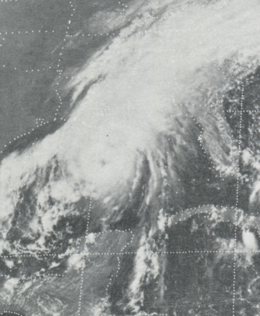Hurricane Eloise
| Category 3 major hurricane (SSHWS/NWS) | |

Hurricane Eloise in the Gulf of Mexico before striking Florida
|
|
| Formed | September 13, 1975 |
|---|---|
| Dissipated | September 24, 1975 |
| Highest winds |
1-minute sustained: 125 mph (205 km/h) |
| Lowest pressure | 955 mbar (hPa); 28.2 inHg |
| Fatalities | 80 direct |
| Damage | $560 million (1975 USD) |
| Areas affected | Lesser Antilles, Greater Antilles, Yucatán Peninsula, Florida, Eastern United States |
| Part of the 1975 Atlantic hurricane season | |
Hurricane Eloise was the most destructive tropical cyclone of the 1975 Atlantic hurricane season. The fifth tropical storm, fourth hurricane, and second major hurricane of the season, Eloise formed as a tropical depression on September 13 to the east of the Virgin Islands. The depression tracked westward and intensified into a tropical storm while passing to the north of Puerto Rico. Eloise briefly attained hurricane intensity soon thereafter, but weakened back to a tropical storm upon making landfall over Hispaniola. A weak and disorganized cyclone, Eloise emerged into open waters of the northern Caribbean Sea; upon striking the northern Yucatan Peninsula, it turned north and began to re-intensify. In the Gulf of Mexico, the cyclone quickly matured and became a Category 3 hurricane on September 23. Eloise made landfall along the Florida Panhandle west of Panama City before moving inland across Alabama and dissipating on September 24.
The storm produced torrential rainfall throughout the islands of Puerto Rico and Hispaniola, causing extensive flooding that led to severe damage and more than 40 deaths. Thousands of people in these areas became homeless as flood waters submerged numerous communities. As Eloise progressed westward, it affected Cuba to a lesser extent. In advance of the storm, about 100,000 residents evacuated from the Gulf Coast region. Upon making landfall in Florida, Eloise generated wind gusts of 155 miles per hour (249 km/h), which demolished hundreds of buildings in the area. The storm's severe winds, waves, and storm surge left numerous beaches, piers, and other coastal structures heavily impaired.
Wind-related damage extended into inland Alabama and Georgia. Further north, torrential rains along the entire East Coast of the United States created an unprecedented and far-reaching flooding event, especially into the Mid-Atlantic States. In that region, an additional 17 people died as a result of freshwater flooding from the post-tropical storm; infrastructural and geological effects were comparable to those from Hurricane Agnes several years prior. Across the United States, damage amounted to approximately $560 million. The storm killed 80 people along its entire track; due to the severe damage, the name "Eloise" was retired from the Atlantic tropical cyclone naming lists.
...
Wikipedia
